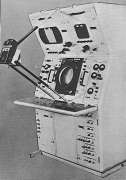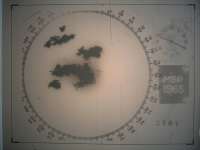AN/FPS-77
Description of the radar set, tactical-technical characteristics

Figure 1: AN/FPS-77 antenna group
 Manufacturer:
Manufacturer:Lear Siegler Inc.
| Specifications | |
|---|---|
| frequency: | 5 450 … 5 650 MHz
(C-Band) |
| pulse repetition time (PRT): | 3 086 µs |
| pulse repetition frequency (PRF): | 324 Hz |
| pulsewidth (τ): | 2 µs |
| receive time: | |
| dead time: | |
| peak power: | 300 kW |
| average power: | 200 W |
| instrumented range: | 200 NM (≙ 370 km) |
| range resolution: | 300 m |
| accuracy: | |
| beamwidth: | 1.68° |
| hits per scan: | |
| antenna rotation: | 0 … 5 … 8 min-1 |
| MTBCF: | |
| MTTR: | |
AN/FPS-77
The AN/FPS-77 is an operating in C-Band storm detection radar. It was developed as a low-cost, medium-range weather radar set to provide information on severe storms for local use. It couldn't measure Doppler frequencies. This radar was the predecessor to the NEXRAD and used over 200 vacuum tubes.
The antenna assembly includes an 8-foot parabolic reflector, fed by a J-type bended feedhorn mounted at the focal point of the reflector. The antenna could be made to sweep automatically in azimuth or elevation, or the antenna could by pointed in a fixed direcion for height or distance analysis.
Target returns are displayed on three scopes at the console and a single scope at the remote indicator. Pertinent data displayed by the three scopes include true range, height, azimuth bearing, and target density. The video is shown on PPI type indicator and an earth curvature–corrected RHI-indicator, both with rotating deflection coils. An additional A-scope with a diameter of 5 inch used electrostatic deflection. The CRT image storage was made by a Polaroid camera.
The AN/FPS-77’s PPI used an interesting but not totally successful dark-trace storage tube that could be operated in lighted environments. It used a long persistent phosphor that indicated the echos in black, not light green. The PPI echos would remain on the CRT up to 1 hour. The scope was back lighted so the black storm images on the scope are shown as a shadow. The images were erased with a heating filament inside the CRT.
The AN/FPS-77(V) were purchased in two increments from 1964 to 1966. In total, 103&nsbp;of these radars were built.
Source:
- Military Standardisation Handbook TM 11-487C-1/MIL-HDBK-162A, Volume 1, p. 137 (online)


